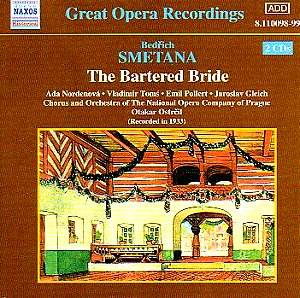 Composer: Bedřich Smetana
Composer: Bedřich Smetana
Works: The Bartered Bride
Performers: Krušina (Jan Konstantin), Ludmila (Marie Pixová), Marenka (Ada Nordenová), Micha (Zdenek Otava), Háta (Mata Krásonová), Vašek (Jaroslav Gleich), Jeník (Vladimír Toms), Kecal (Emil Pollert), Principal of the comedians (Karel Hruška), Esmeraldra (Otta Horáková), Indian (Václav Marek), Orchestra and Chorus of the National Opera Company of Prague
Recording: Recorded in Vienna, from 6 to 23 June 1933
Label: Naxos Historical 8.110098-99 [2 CDs 117.51]
Bedřich Smetana’s The Bartered Bride stands as a cornerstone of Czech opera, blending folk elements with a narrative that vibrantly captures the complexities of love and societal norms in 19th-century Bohemia. This recording, made in the twilight of the interwar period, presents not only a historical artifact but also a vivid rendering of Smetana’s musical landscape. The opera’s lush overture and infectious dance sequences remain staples in both concert halls and opera houses worldwide, showcasing the composer’s ability to weave engaging melodies with a playful yet poignant narrative.
Under the deft baton of conductor Otakar Ostrcil, the performance radiates an energetic clarity that is emblematic of the Czech operatic tradition during the 1920s and 30s. The cast, comprised of some of the finest singers of the era, delivers a cohesive and spirited interpretation, with Ada Nordenová’s portrayal of Marenka standing out for its lively charm. Her voice dances effortlessly through Smetana’s lyrical lines, capturing the character’s youthful exuberance while maintaining a clarity of tone that resonates beautifully in the ensemble passages. Vladimír Toms as Jeník complements her with a robust yet nuanced tenor, his phrasing imbued with a romantic yearning that adds depth to their duet, “Tuzemské hrdlo.”
The ensemble work is particularly noteworthy, revealing the years of collaboration among the performers. Their well-honed interplay is a testament to Ostrcil’s direction, facilitating a seamless blend of individual voices within the larger choral textures. Moments such as the exuberant “Trampoty” chorus illustrate the ensemble’s ability to balance precision with spontaneity, resulting in a performance that feels both meticulously crafted and joyfully alive. The chorus, unyielding in its exuberance, often takes center stage, embodying the communal spirit that Smetana sought to capture.
While the remastered audio by Ward Marston presents a generally clean sound with good presence for the voices, the orchestral textures occasionally suffer from muddiness, detracting slightly from the overall listening experience. The strings, at times, lack the brilliance that characterizes more modern recordings, making phrases feel less defined. For listeners seeking pristine sound quality, alternatives like the Supraphon recording featuring Gabriela Benacková may serve better, although they lack this historical ensemble’s unique charm.
The historical significance of this recording cannot be overstated; it captures a moment when Czech operatic identity was solidifying in the face of global upheaval. The performers, assembled from the National Opera of Prague, embody a rich tradition of Czech musicality that resonates throughout the performance. This recording, the first of The Bartered Bride, provides invaluable insight into the way Smetana’s work was interpreted during a pivotal period in both his homeland’s history and the evolution of operatic performance.
The Naxos Historical release of The Bartered Bride is an essential listen for those interested in the development of Czech opera and its vibrant musical language. The combination of a passionate cast, spirited conducting, and the historical context of the recording offers a compelling glimpse into an era of operatic artistry that feels both distant and immediate. This performance encapsulates the joy and complexity of Smetana’s creation, making it a worthy addition to any classical music collection.



